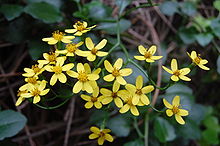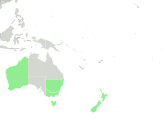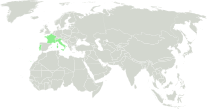- Senecio angulatus
-
Senecio angulatus 
Creeping groundsel Scientific classification Kingdom: Plantae (unranked): Angiosperms (unranked): Eudicots (unranked): Asterids Order: Asterales Family: Asteraceae Tribe: Senecioneae Genus: Senecio Species: S. angulatus Binomial name Senecio angulatus
L.f. (1781)
Range of S. angulatus Synonyms Senecio macropodus DC.
Sources: IPNI,[1] AFPD,[2] GRIN,[3] NZPND,[4] ALUKA[5]Senecio angulatus also known as Creeping groundsel[6] and sometimes as Cape ivy[7] is a climbing succulent perennial from the family Asteraceae of the genus Senecio; a native of South Africa[8] an alien in Australia,[9] a problem weed in New Zealand,[10] naturalized in North Africa,[2] and cultivated elsewhere.[11][12]
Senecio tamoides has been misapplied in Australia and is currently considered to be Senecio angulatus.[13]
Contents
Description
Described as scrambling[10] and as a twining herb[9] whose form is a dense tangled shrub 2 metres (6.6 ft) tall[14] or a climber to 6 metres (20 ft) high,[9] that can become an aggressive weed once established[4] smothering the existing native vegetation both in the ground layer and canopy and altering the light climate in the invaded community and sometimes suppressing the regeneration of native plants.[14]
Stems and leaves: Succulent, pale green stems, often variegated with pale yellow green and purple, slightly angular[5] (not upright) and usually sparingly branched.[4] Neither stems nor leaves are hairy.[4][5][15]
Thick, glossy, fleshy, coarsely toothed leaves, with one to three teeth each side[4] and bluntly lobed,[14] with upper leaves becoming smaller with fewer teeth or none at all.[4] Leaves are 3.7 centimetres (1.5 in) to 22 centimetres (8.7 in) long and 1 centimetre (0.39 in) to 14 centimetres (5.5 in) wide and occur in 1-4 pairs.[5] Leaf stalks are 1 centimetre (0.39 in) to 4 centimetres (1.6 in) long.[15] The leaves have stalks or stems which embrace the larger leaf surface which is not lobed, oval to triangularly shaped or very blunt to pointed at the tips and blunt to flat at the base. The leaves have a frosted look from a powdery coating on the lower side.[5]
Senecio angulatus will climb if suitable support available.[14]
It can be distinguished vegetatively from Senecio mikanioides by the lack of lobes at the leaf stalk base, the fleshy leaf surface, the outwardly curved leaf teeth.[4]
Flowers: Senecio angulatus produces numerous flowers[5] in open clusters at the end of its branches or stems.[4] Strongly scented flowers on an elongated stem that continue to open in succession from the base up as the stem continues to grow; the mass of clusters ending more flat at the top than pyramid-like,[5] 4 centimetres (1.6 in) to 8 centimetres (3.1 in) in diameter.[15] Often the cluster droops with the flower heads at the end of the cluster turning upwards.[5]
Flower stalks are mostly hairless or with some short hairs, 6.5 millimetres (0.26 in) to 10.5 millimetres (0.41 in) long. Flower heads are attached to flower stalk by fine pointed 8-11 bracts 5 millimetres (0.20 in) to 6 millimetres (0.24 in)[4] which are surrounded by 4-7 pale green and sometimes purple tinged at the base supplementary bracts, 1.5 millimetres to 2.5 millimetres which make a cup shape around the base of the involucre.[5] Each stalk is capable of producing 10-15 disc florets.[15]
Flower-heads are radiate and urn-shaped,[15] ray florets are nearly always absent[5] yellow ligule when they occur. The corolla has a yellow disc[4] surrounded by 4–6 dull golden yellow disc florets 5.5 millimetres (0.22 in) to 9.5 millimetres (0.37 in) long with hairless tubes, a slight expansion below the middle and lobes 1.3 millimetres to 2 millimetres wide.[5]
Flowering from April to May in Africa[9] and May to July in New Zealand;[15] S. angulatus flower heads have rays[4] (that look like petals) that make it more daisy-like[14] unlike S. mikanioides which doesn't.[15]
Fruits and reproduction: Creeping groundsel is easily dispersed by wind-blown seed, stem fragments, and dumped garden waste.[14] Achenes are 3 millimetres to 4 millimetres long,[4][5] ribbed or grooved with short hairs in the grooves[4][5] and a tapering cylindrical shape.[4][15] The parachute like hairs, the pappus, are 5 millimetres to 7 millimetres long.[4][15]
Common names
- English: Creeping groundsel[6]
- French: Séneçon anguleux[12]
- Italian: senecio rampicante[16]
- Xhosa: inDindilili[7]
Distribution
Preferring soils of black calcareous and grey sand, sandy clay and limestone; and finding homes with these soils in coastal areas on cliff faces, mudflats, wet depressions in dunes, near swamps,[9] in landfills and scrubland and near settlements[15] especially near the sea.[4]
Native:
- Afrotropic
- Southern Africa: South Africa
Current
- Afrotropic
- East Tropical Africa: Uganda, Kenya, Tanzania
- Southern Africa: South Africa
- Australasia
- Western Australia: (Esperance Plains, Warren, Swan Coastal Plain), New South Wales, Victoria, Tasmania.
- New Zealand: New Zealand North, New Zealand South (Nelson City, Wairau Bar (Marlborough), Banks Peninsula)
- Palearctic
- Macaronesia: Canary Islands (Gran Canaria, Hierro, Tenerife), Balearic Islands (Ibiza, Formentera, Mallorca, Menorca)
- Southwestern Europe: Corsica, Channel Islands, France & Monaco, Portugal
- Southeastern Europe: Italy, Sardinia, Sicily and surrounding islands
Sources: GRIN,[3] ALUKA,[5] FBAF,[9] NSWF,[15] NZPND,[4] BGB[12]
- Range maps
References
- ^ International Organization for Plant Information (IOPI). "Plant Name Search Results" (HTML). International Plant Names Index. http://www.ipni.org/ipni/idPlantNameSearch.do?id=243791-1. Retrieved 2008-05-29.
- ^ a b "Senecio angulatus L.f. record n° 97995". African Flowering Plant Database. http://www.ville-ge.ch/cjb/bd/africa/details.php?langue=an&id=97995. Retrieved 2008-03-31.
- ^ a b Germplasm Resources Information Network (GRIN) (2004-09-15). "Taxon: Senecio angulatus L. f.". Taxonomy for Plants. USDA, ARS, National Genetic Resources Program, National Germplasm Resources Laboratory, Beltsville, Maryland. http://www.ars-grin.gov/cgi-bin/npgs/html/taxon.pl?447151. Retrieved 2008-03-31.
- ^ a b c d e f g h i j k l m n o p q Landcare Research. "Senecio angulatus L.f. Suppl. 369 (1781)". Flora of New Zealand: Taxa. Landcare Research Allan Herbarium and New Zealand Plant Names Database. http://floraseries.landcareresearch.co.nz/pages/Taxon.aspx?id=_50e4f74e-a0b2-4dbe-9d34-112367ca3cbf&fileName=Flora%204.xml. Retrieved 2008-04-01.
- ^ a b c d e f g h i j k l m n "Senecio angulatus L.f.". 2006-01-13. doi:10.5555/AL.AP.COMPILATION.PLANT-NAME-SPECIES.SENECIO.ANGULATUS. http://www.aluka.org/action/showCompilationPage?doi=10.5555/AL.AP.COMPILATION.PLANT-NAME-SPECIES.SENECIO.ANGULATUS. Retrieved 2008-03-31.
- ^ a b Muyt, Adam (2001). Bush invaders of south-east Australia: a guide to the identification and control of environmental weeds in south-east Australia. R.G. and F.J. Richardson. pp. 304 pages. ISBN 0958743975. http://www.weedinfo.com.au/bk_bushi.html. Retrieved 2008-03-31.
- ^ a b Quattrocchi, Umberto (2000). "Page 2456". CRC World Dictionary of Plant Names: Common Names, Scientific Names, Eponyms, Synonyms, and Etymology. CRC Press. ISBN 0849326737. http://books.google.com/books?id=2ndDtX-RjYkC&pg=PA2456&lpg=PA2456&source=web&ots=2_01ZpOfIm&sig=VXR3ApmWCcqjvMDNiDlh9fhETcU&hl=en. Retrieved 2008-04-14.
- ^ "Senecio angulatus L.f.". 1931-07. doi:10.5555/AL.AP.VISUAL.PREART0001908. http://www.aluka.org/action/showMetadata?doi=10.5555/AL.AP.VISUAL.PREART0001908. Retrieved 2008-03-31.
- ^ a b c d e f Western Australian Herbarium (2007-09-11). "Senecio angulatus L.f.". FloraBase. Government of Western Australia. http://florabase.calm.wa.gov.au/browse/profile/20665. Retrieved 2008-03-31.
- ^ a b "Cape ivy (Senecio angulatus)". Controlling problem weeds in riparian zones. Greater Wellington Regional Council. 2004. http://www.gw.govt.nz/story10945.cfm. Retrieved 2008-03-31.[dead link]
- ^ "Parks where cultivated Senecio angulatus". Institut Botànic de Barcelona. http://www.latalaia.net/arbres/parcs.asp?l=en&ID=242. Retrieved 2008-03-31.
- ^ a b c Botanic Garden and Botanical Museum Berlin-Dahlem. "Details for: Senecio angulatus". Euro+Med PlantBase. Freie Universität Berlin. http://ww2.bgbm.org/EuroPlusMed/PTaxonDetail.asp?NameId=7000627&PTRefFk=7000000. Retrieved 2008-03-31.
- ^ Western Australian Herbarium (2007-09-11). "Senecio angulatus L.f.". FloraBase. Government of Western Australia. http://florabase.calm.wa.gov.au/search/current/20665. Retrieved 2008-03-31.
- ^ a b c d e f Tom Forney, Steve Hurst (2007). "Kudzu Pueraria lobata" (PDF). Government of Oregon. http://pebb.das.state.or.us/ODA/PLANT/WEEDS/docs/pdf/weed_card_vines.pdf. Retrieved 2008-03-31.
- ^ a b c d e f g h i j k National Herbarium of New South Wales. "Senecio angulatus L.". New South Wales FloraOnline. Royal Botanic Gardens, Sydney. http://plantnet.rbgsyd.nsw.gov.au/cgi-bin/NSWfl.pl?page=nswfl&lvl=sp&name=Senecio~angulatus. Retrieved 2008-03-31.
- ^ "Senecio angulatus". http://it.wikipedia.org/wiki/Senecio_angulatus. Retrieved 2008-04-02.
External links
 Media related to Senecio angulatus at Wikimedia Commons
Media related to Senecio angulatus at Wikimedia Commons Data related to Senecio angulatus at Wikispecies
Data related to Senecio angulatus at Wikispecies- University of California, Berkeley. "CalPhotos Photo Database". CalPhotos. Biodiversity Sciences Technology (BSCIT). http://calphotos.berkeley.edu/cgi/img_query?stat=BROWSE&query_src=photos_flora_sci&where-genre=Plant&where-taxon=Senecio+angulatus. Retrieved 2008-03-31.
- "Herbarium record". Neotropical Herbarium Specimens. fieldmuseum.org. http://fm1.fieldmuseum.org/vrrc/?page=view&id=7237. Retrieved 2008-04-22.
Categories:- Senecio
- Flora of Southern Africa
- Creepers of South Africa
Wikimedia Foundation. 2010.






